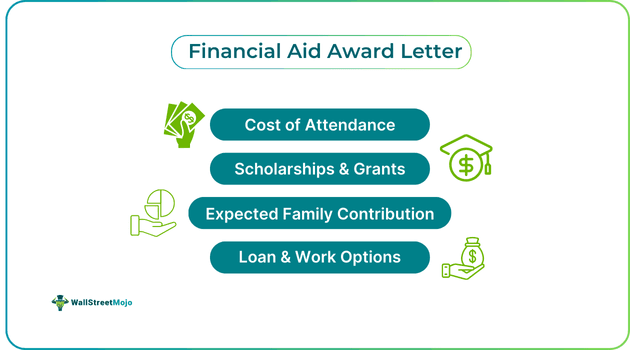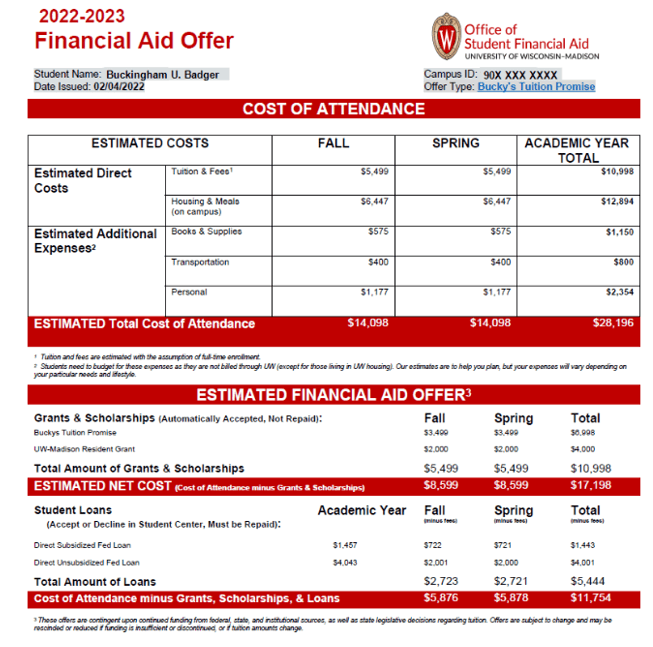Table of Contents
What Is A Financial Aid Award Letter (FAFSA Award Letter)?
A financial aid award letter, or FAFSA financial aid award letter, is an official document sent to a student from their university or college that specifies how much financial support they are eligible for. This letter is sent as a result of the student applying for the Application for Federal Student Aid (FAFSA), which is filled out when students apply to attend university or college.

The letter includes various details, such as the Cost of attendance, expected family contribution, loan options, and scholarship or grant options. Since it has a detailed account of all the costs involved, it gives students the transparency to curate a budget accordingly. However, the fact that the format and minute details vary by institution complicates the comparison between the two institutions.
Key Takeaways
- The financial aid award letter is an official document that determines whether a student is eligible for financial aid and, if so, the quantum of their eligibility.
- To be eligible for federal financial aid, students must complete the Free Application for Federal Student Aid (FAFSA).
- These letters comprise grants and scholarships that need not be repaid. They also include loan options that must be repaid after a certain period.
- The difference between the Cost of attendance and grants or scholarships must be borne by the student through debt or other sources.
Financial Aid Award Letter Explained
A financial aid award letter is official documentation provided by a university or college specifying the financial aid package awarded to the student for a particular academic year. It shows the various financial aid options available to students, such as scholarships, grants, and loans.
The estimated financial aid award letter details the different factors that affect the financial aspect of the student’s education in that academic year. Cost of attendance, expected family contribution, loan options, student aid index, and other programs that the college often has are significant players on that list.
It is the result of students or their parents filling out the FAFSA form to get federal financial aid. After reviewing the application, it shows if the student is eligible for financial aid. If yes, how much they are eligible for is also mentioned in the declaration.
The significant advantage is that students are not obliged to accept whatever offer a university makes. They can wait, compare other offers, and choose whichever option meets their requirements.
One of the major headaches for students worldwide is that the debt that accumulates takes years to repay. Therefore, these financial aids allow students to reduce their debt obligations and make the most of the financial aid to gather much-needed education and experience.
What It Includes?
A financial aid award letter template varies by university or college. However, the U.S. Department of Education requires the following information:
- Cost of Attendance: It is an approximation of the expenses the student might incur within the academic year to attend a particular school. It includes costs such as tuition, boarding, books, supplies, transportation, fees, and other expenses. However, it is essential to note that CoA does not include all expenses a student might incur.
- Expected Family Contribution: This is the portion of the fees that the student’s family will pay. The expected amount is determined by the details entered in the FAFSA. It helps authorities decide how much financial aid a student might require to cover their costs.
- Loan & Work Options: The second half of an award letter details the loan options available to the student. It includes the amount, interest rates, and loan type. Additionally, suppose the student qualifies for the federal work-study option. In that case, it also specifies how much a student can earn in a year and how many hours they are permitted to work.
- Scholarship & Grant Options: These letters typically offer multiple types of awards to the student. This section of the letter has options that do not require repayment. In fact, most of these options are merit-based. The most common options are institutional grants, state or federal grants, employer-paid tuition, and other types of gift aids.
- Net Costs: The net Cost of attending school is the Cost of attendance minus scholarships and total grants awarded to the student. It refers to the amount that the student has to pay out of their pocket or through loans or other financial aid.
Sample
While the exact format of a FAFSA financial aid offer letter differs from university to university, most factors remain the same. Below is a sample from one of the leading universities for reference.

How To Find?
Depending on the university or college, the communication of receiving an estimated financial aid award letter can vary. A few of the most common channels of communication where students can find their letters are:
- Email: Most colleges process financial aid letters through emails, which are one of the most established channels of formal communication. Therefore, students must keep a close eye on their email inboxes.
- College Portal: Colleges also have a unique student portal where all communication takes place. The update in this regard might also be communicated through the portal on the university’s official website.
- Mail: A handful of universities and colleges still choose to communicate by orthodox mail delivery methods. They print the information on paper and send it through mail.
- Financial Aid Office: If a student feels that communication has yet to reach them within a stipulated period, most colleges have a dedicated student aid department. Students can contact them directly to understand the options they have been awarded.
How To Read?
It has been well-established that there is no standard methodology or format for a financial aid letter. However, below are a few factors that students must invariably consider and read through before making a decision.
- Cost of Attendance: The CoA figure refers to the total Cost of attending school for an academic year. This might be an excellent place to start, as it determines the expenses related to fees, room and board, tuition, and books.
- Types of Financial Aid: Students must review all the listed options of scholarships, loans, work-study programs, and grants. While doing so, they must keep in mind that scholarships or grants need not be repaid, while loans must be.
- Loan Terms: Loans are long-term financial obligations. Therefore, students must thoroughly review the loan amount, tenure, and interest rates to ensure they avoid incurring a financial burden beyond their bandwidth.
- Net Price: The Net Price refers to the amount that the student has to pay out of pocket. After subtracting any scholarships or grants from the CoA, that figure refers to the net price of attending school for an academic year. Students have to cover these costs through loans or other sources.
Examples
Now that the theoretical aspects of a financial aid award letter template are out of the way, it is time to address the concept's practical applicability through the examples below.
Example #1
Justin applied to various universities to pursue a Bachelor’s degree in Mechanical Engineering. He and his parents also filled out the FAFSA and applied for financial aid. Upon receiving the letter, Justin was awarded a scholarship of $2,500 and a grant of $500. Additionally, he had the option of availing himself of a fully subsidized federal loan of up to $3,000.
Ultimately, after deducting all grants and scholarships from the CoA, Justin had to arrange $2,700, which he did from the federal loan. Its repayment started only one year after he secured his degree. Hence, he chose that option and studied in his dream college.
Example #2
The Free Application for Federal Student Aid (FAFSA) awarded almost $235 billion towards student aid in the academic year 2021-2022. The average grant, according to the National Centre for Education Statistics, was approximately $14,080.
The U.S. Department of Education has doubled its average grant amount in the last decade. The average grant in 2001 was $5,190, and in 2021, it was $10,590.
